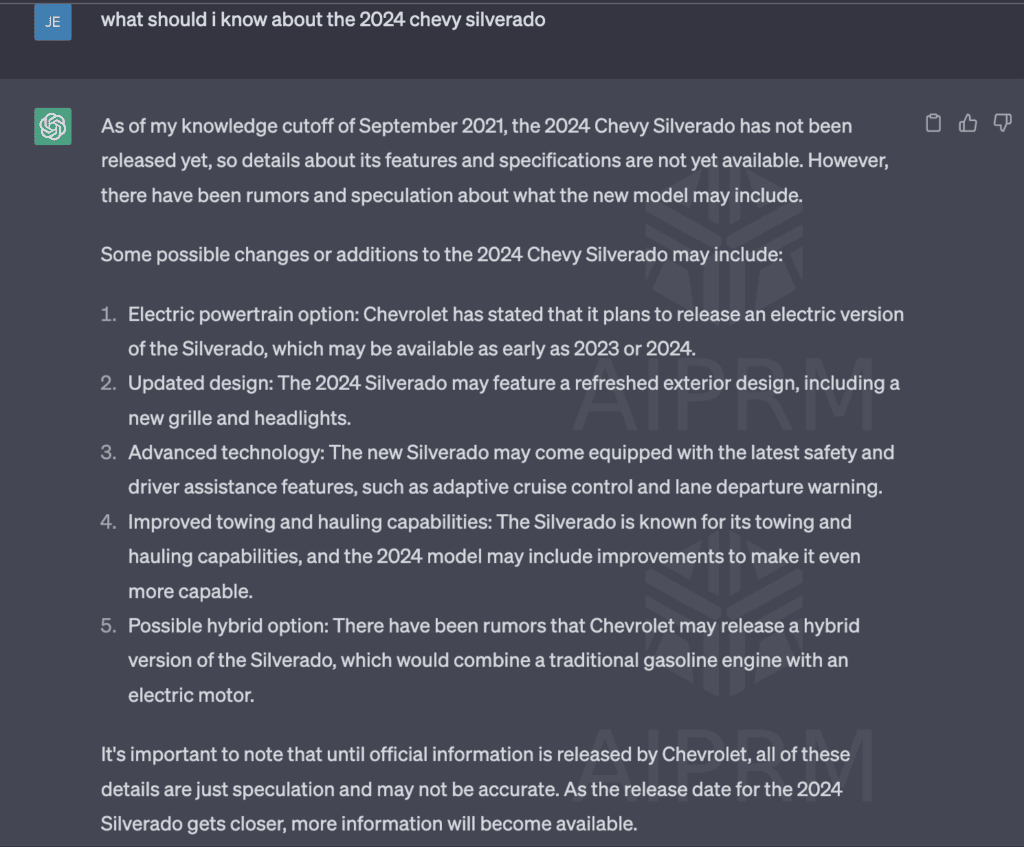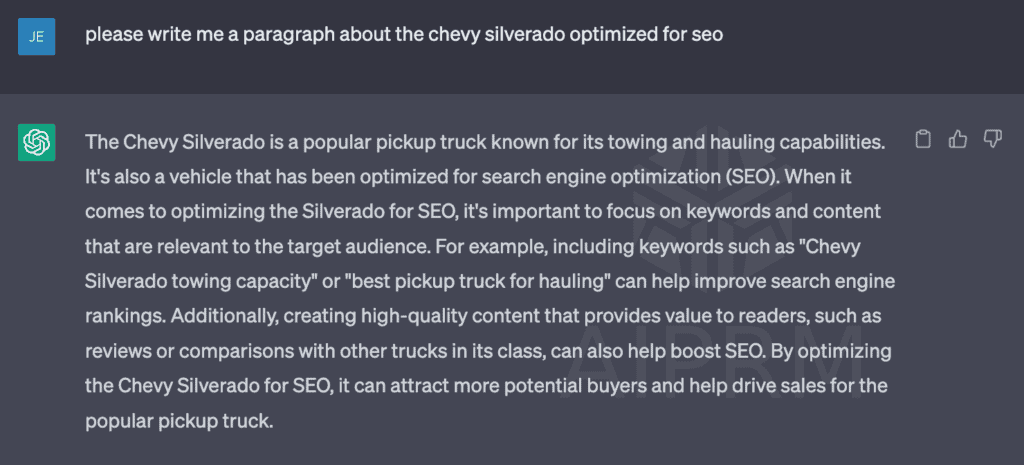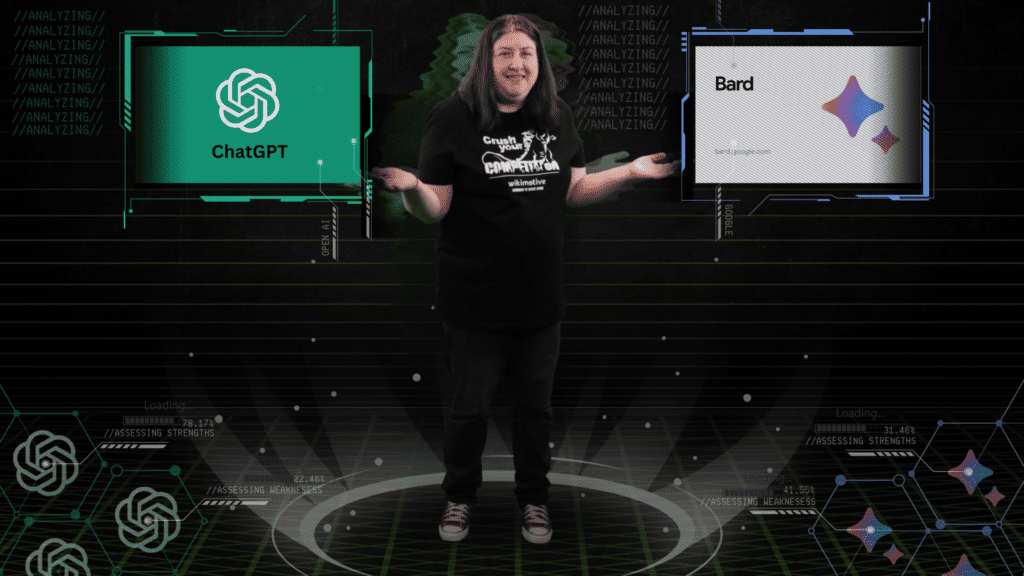
Artificial intelligence (AI) is all the rage right now, with the advent of several different AI tools and language models that have shown the ability to create art, pass certification exams, and even create music. AI has been in the news recently due to the implications it may have in the world of SEO, where two language models have been battling it out to see which is most effective: Google’s Bard or OpenAI’s ChatGPT.
While other tools do exist online with the ability to outline and even create full pieces of content, Bard and ChatGPT are the two in the foreground of digital marketing and automotive SEO right now. With so many options available online, it’s important to know what you can use and for what. Today, we’ll be going over ChatGPT and Bard and when it may be appropriate to use each.
What is ChatGPT, and How Does It Function?
ChatGPT is an artificial intelligence language model built on Generative Pre-trained Transform (GPT) architecture and released in November 2022. As a chatbot, it is able to respond in conversational text when answering user queries, though its knowledge base extends only through September 2021. ChatGPT can be used for a number of applications, from generating content to writing code and summarizing different forms of media or events.
One of the most noteworthy features of ChatGPT is its ability to write and respond to prompts in conversational tones, which can be used to generate content topics and even the structure of a written piece. For some prompts, it could even hypothetically be used to optimize the piece for search. However, ChatGPT has its limitations.
While it may be able to optimize for the machine-learning parts of search engines, ChatGPT is unable to account for the human element of SEO, meaning that parts of its content generated will lose some of the flow you might expect when reading an article online.
Additionally, because the information involved in the framework of the tool stops in late September 2021, it cannot answer queries accurately for products or events that have occurred in the months since. For example, when asked about the 2024 Subaru Crosstrek Wilderness, a major vehicle release announced at the beginning of April 2023, ChatGPT could only speak to the 2021 model, admitting that any information about future model releases would be “currently speculative.”
What is Bard, and How Does It Work?
Bard is Google’s response to the rise of artificial intelligence and online chatbots. Released in March 2023, Bard is currently in the process of being rolled out to users and is expected to be made widely available in search results in the coming months. In contrast to ChatGPT, Bard pulls its responses directly from the internet. Bard also uses a different language model (Language Model for Dialogue Applications, or LaDMA) in its code, which consists of trillions of words and search terms that help with predictive text and allow the bot to follow trends to continue a conversation with the user.
Similarly to ChatGPT, Bard comes with several key flaws and issues. Although the data pool is kept fully up-to-date since it pulls directly from the internet, Bard can also pull incorrect information when answering queries, making it critical to double-check any information found in your answers.
When asked to optimize for search, the results are also lacking, often produced in the form of bulleted lists without proper heading tags or formatting. Most responses are followed by a list of keywords used to optimize and populate the written text. Because Bard results come directly from online sources, they often lack the human touch that makes content easier for the reader to digest, especially when reading a list of specs for a new vehicle.
Comparing Bard and ChatGPT: A Case Study
There are plenty of ways Bard and ChatGPT differ. While Bard is continuously pulling the latest information available online about a topic, ChatGPT is limited by the end date of its source data in September 2021. To test this, I asked both tools what I should know about the 2024 Chevy Silverado and got wildly different results.
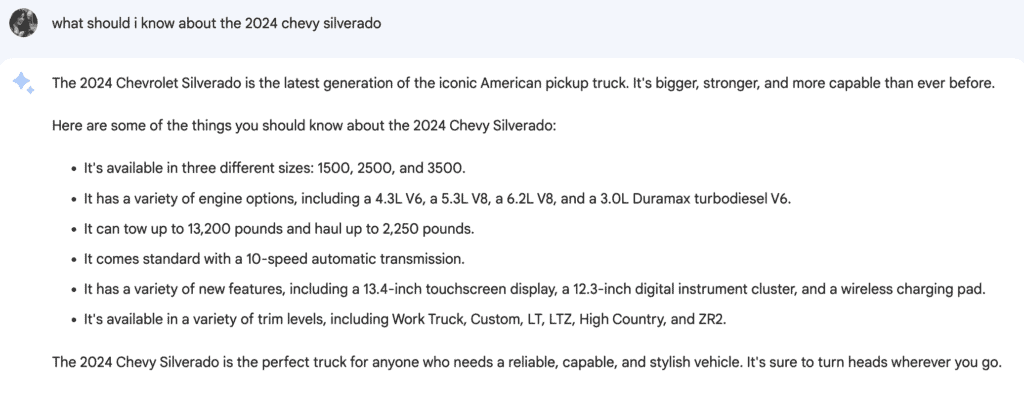
While ChatGPT admitted that any information it could repeat about the model was purely speculative based on what was available in late 2021, Bard was able to provide the latest specs for the vehicle, including configurations, engine options, and internal features.
However, when asked to write a paragraph about the truck optimized for search, neither bot performed particularly well. Bard was able to write a paragraph summarizing the specs but did so without optimizations, generating a list of relevant keywords under the same prompt. ChatGPT, on the other hand, wrote about optimizing the truck itself for SEO.
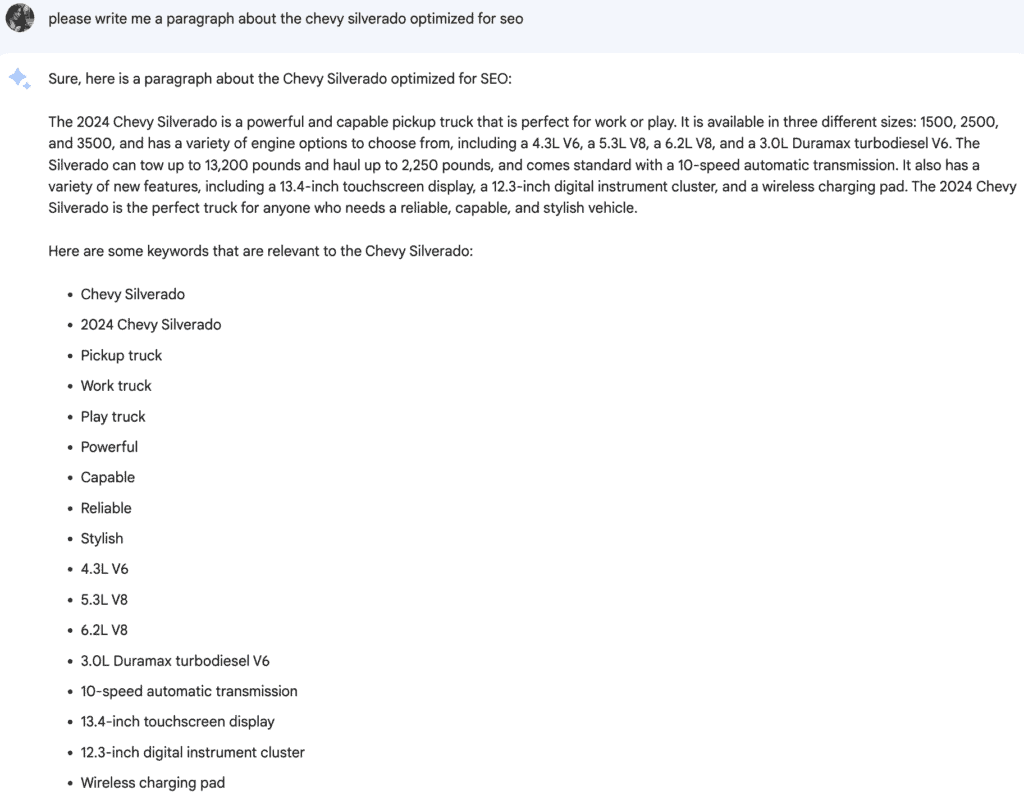
Interestingly, both tools were able to provide lists of the pros and cons of using their services. ChatGPT made sure to mention its real-time responses as well as its versatility: you can access the tool on your phone or tablet as well as on computers. While Bard can be used on a smartphone’s web browser, it does not have its own application yet. Bard also does not write its responses in real-time but can provide an answer to your query in 5 – 10 seconds. Both tools also cite their ability to work in a number of different mediums, including poetry, letters, code, and emails.
When it comes to cons, both are honest about their potential to provide incomplete or inaccurate responses based on their data sets and the pitfalls of machine learning. They also acknowledged the fact that, as language models, their answers will lack the human touch of speaking with an actual customer service representative, as well as the personalization for your specific query and situation. Finally, while both Bard and ChatGPT are able to work across different mediums, ChatGPT is limited solely to text interactions, while Bard is able to borrow from Google’s voice-to-text functionality when processing queries.
What You Should Take Away From AI & SEO
The bottom line is that while tools like ChatGPT and Bard can be used to help generate ideas and even outlines for website content, they can’t be used as your sole source of search engine optimization. When using them to flesh out your ideas or to see what areas you might be missing to attract customers, Bard and ChatGPT can each be utilized in different ways to get the most out of the tool. If you are trying to figure out what belongs in an outline of a piece or want to take a look at a draft of something to get inspired, ChatGPT is going to be a better use of resources and time. If you want a list of keyword ideas or are looking for something more creative in nature, you’ll likely get more out of using Bard for your queries.
No matter which tool best suits your needs, it’s important to note that there is no AI equivalent of high-quality content with relevant, useful optimizations. Only actual humans are able to create this type of truly meaningful content that works for both search engines and consumers looking for information.
Want to Optimize Your Website?
If you are interested in getting help with further optimizing your website, contact Wikimotive today to learn more about our range of SEO and content services! While our team of professionals stays updated on the goings-on in the world of AI and its implications for SEO, all of our work is unapologetically human: completely original to your site, free from penalties from search engines, and custom-made for your unique audience.
